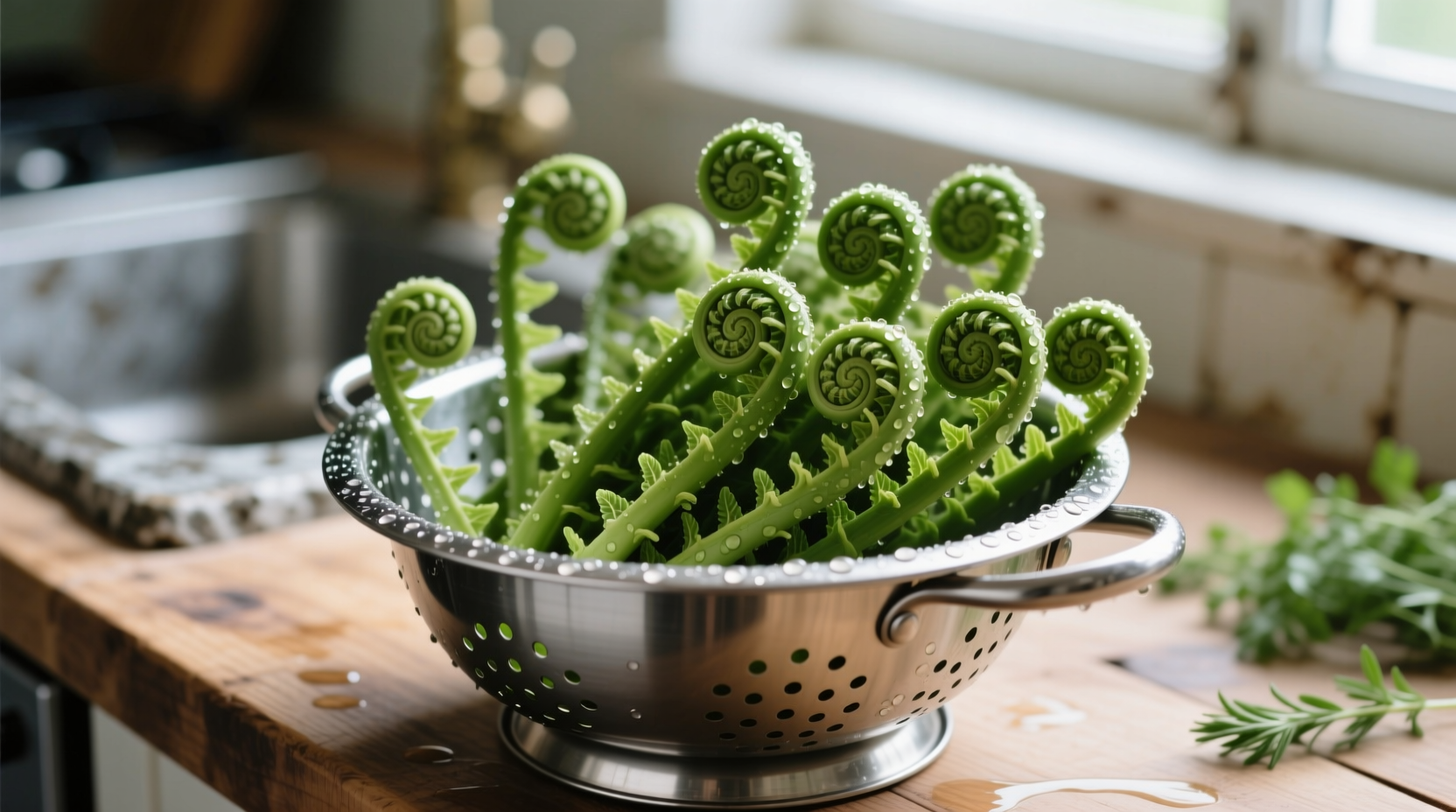Properly cooked fiddlehead ferns are safe to eat and offer a unique asparagus-like flavor with grassy notes. Always boil ostrich fern fiddleheads for 15 minutes or steam for 10-12 minutes before consumption to eliminate naturally occurring toxins that can cause foodborne illness. Never eat raw fiddleheads and discard cooking water after preparation.
Have you ever wondered how to transform those intriguing spiral-shaped vegetables from the forest into a delicious spring delicacy? You're not alone. Each year as fiddlehead season arrives, thousands of home cooks search for reliable guidance on preparing these unique forest greens. This comprehensive guide delivers exactly what you need: step-by-step instructions, safety protocols, and chef-tested recipes that guarantee perfect results every time.
Why Proper Fiddlehead Preparation Matters
Fiddleheads, specifically from the ostrich fern (Matteuccia struthiopteris), contain naturally occurring compounds that can cause foodborne illness if not properly prepared. According to the Maine Department of Agriculture, Conservation and Forestry, improperly prepared fiddleheads have been linked to cases of food poisoning with symptoms including nausea, vomiting, and diarrhea.
| Preparation Method | Minimum Time Required | Risk Level | Recommended By |
|---|---|---|---|
| Boiling | 15 minutes | Low | University of Maine Cooperative Extension |
| Steaming | 10-12 minutes | Low | Canadian Food Inspection Agency |
| Sautéing only | Under 10 minutes | High | Avoid - insufficient cooking |
| Raw consumption | N/A | Very High | Never recommended |
Selecting Perfect Fiddleheads
Your cooking success begins with proper selection. Not all ferns produce edible fiddleheads—only the ostrich fern is widely considered safe for consumption. Look for these identifying characteristics:
- Brown, papery sheath covering the coil (scaly exterior)
- Deep U-shaped groove running down the inside of the stem
- Firm, crisp texture with no slime or discoloration
- Harvested when 1-6 inches tall (before fronds unfurl)
Avoid fiddleheads with:
- Woody or fibrous stems
- Strong odor
- Any sign of insects or damage
Step-by-Step Cleaning Process
Proper cleaning removes the papery husk and any forest debris:
- Place fiddleheads in a large bowl of cold water
- Gently rub to loosen brown husks (wear gloves if sensitive skin)
- Swish fiddleheads to remove loose debris
- Drain water and repeat until water remains clear
- Use a soft brush to remove stubborn particles if needed
- Inspect each fiddlehead individually for remaining husk fragments

Safe Cooking Methods That Guarantee Delicious Results
After thorough cleaning, proper cooking is non-negotiable for safety. Here are the two safest preparation methods:
Boiling Method (Most Recommended)
- Bring 4 quarts of water to a rolling boil per pound of fiddleheads
- Add 1 tablespoon salt to the water
- Carefully add cleaned fiddleheads
- Boil for exactly 15 minutes
- Drain immediately and rinse with cold water
- Discard cooking water (contains toxins)
Steaming Method
- Bring 2 inches of water to boil in a pot with steamer basket
- Add cleaned fiddleheads to the basket
- Cover and steam for 10-12 minutes
- Check for tenderness (should pierce easily with fork)
- Remove immediately and cool
According to the Canadian Food Inspection Agency, boiling or steaming are the only safe preparation methods. Sautéing alone does not reach sufficient temperatures to destroy all potential toxins.
Transforming Cooked Fiddleheads Into Gourmet Dishes
Once properly cooked, fiddleheads become incredibly versatile. Try these chef-approved finishing techniques:
Lemon-Garlic Sautéed Fiddleheads
After boiling, heat 2 tablespoons olive oil in a skillet over medium heat. Add 2 minced garlic cloves and sauté for 30 seconds until fragrant. Add cooked fiddleheads, 1 tablespoon lemon juice, salt, and freshly ground black pepper. Toss gently for 2-3 minutes until heated through and lightly caramelized.
Fiddlehead Risotto
Prepare your favorite risotto recipe through the broth addition stage. In the last 5 minutes of cooking, fold in 1 cup of pre-boiled fiddleheads. Finish with grated Parmesan and a squeeze of lemon.
Fiddlehead and Potato Soup
Sauté onions and garlic, add diced potatoes and vegetable broth. Simmer until potatoes are tender, then add pre-cooked fiddleheads during the last 5 minutes of cooking. Finish with fresh dill and a splash of cream.
Seasonal Availability and Regional Considerations
Fiddleheads are a true spring delicacy with a narrow harvesting window. Understanding their seasonal pattern helps you enjoy them at peak quality:
- Eastern Canada and Northeastern US: Late April to early June (varies by elevation)
- Mid-Atlantic US: Early to mid-May
- Pacific Northwest: April through May
Never harvest fiddleheads from areas contaminated by road runoff, industrial sites, or areas treated with pesticides. The University of Minnesota Extension emphasizes that fiddleheads absorb environmental contaminants, making location selection critical for safety.
Storage Guidelines for Maximum Freshness
Fiddleheads are highly perishable. For best results:
- Store uncleaned fiddleheads in a perforated plastic bag in the refrigerator
- Use within 2-3 days of harvest
- Do not wash until ready to prepare
- Cooked fiddleheads can be refrigerated for up to 3 days
- For long-term storage, blanch properly cooked fiddleheads and freeze
Nutritional Benefits of Properly Prepared Fiddleheads
When prepared correctly, fiddleheads offer impressive nutritional value per 100g serving:
- Rich in antioxidants (higher than blueberries in some varieties)
- Excellent source of omega-3 and omega-6 fatty acids
- High in vitamin A, vitamin C, and potassium
- Contains significant dietary fiber
- Low in calories (approximately 34 calories per 100g)
These nutritional benefits only become safely accessible through proper preparation methods that eliminate naturally occurring toxins.
Avoiding Common Fiddlehead Preparation Mistakes
Even experienced cooks make these critical errors:
- Mistake: Skipping the boiling/steaming step and going straight to sautéing
Solution: Always pre-cook using recommended methods before finishing in a pan - Mistake: Using the cooking water for sauces or soups
Solution: Discard all cooking water as it contains concentrated toxins - Mistake: Confusing edible ostrich ferns with toxic varieties
Solution: Learn proper identification or purchase from reputable sources











 浙公网安备
33010002000092号
浙公网安备
33010002000092号 浙B2-20120091-4
浙B2-20120091-4